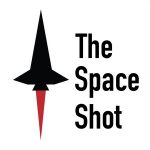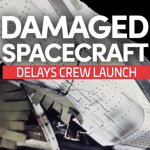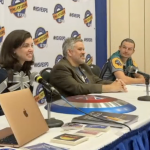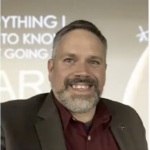 This episode is jam-packed with awesome guests and Skylab stories. Emily Carney, David Hitt, and Dwight Steven-Boniecki joined to talk about all things Skylab, give it a listen!
This episode is jam-packed with awesome guests and Skylab stories. Emily Carney, David Hitt, and Dwight Steven-Boniecki joined to talk about all things Skylab, give it a listen!
Category Archives: Media
Astro Live: This BROKEN Spacecraft Required a Repair Plan… BEFORE the Crew Launched
 A crewed rocket sat on the pad, ready to follow a ground-breaking launch into space… but an anomaly during the uncrewed launch of equipment left the mission in doubt. Is it safe to send the astronauts? It’s not science fiction. It’s not even a recent mission. But what can we learn from stories of spacecraft launched 50 years ago?
A crewed rocket sat on the pad, ready to follow a ground-breaking launch into space… but an anomaly during the uncrewed launch of equipment left the mission in doubt. Is it safe to send the astronauts? It’s not science fiction. It’s not even a recent mission. But what can we learn from stories of spacecraft launched 50 years ago?
In 1973, America launched its first space station and observatory: Skylab. This program was the precursor to the International Space Station and allowed scientists to explore, in-depth, the challenges of long-duration human spaceflight, leading to the development of special facilities and equipment designed to function in microgravity. Three crews conducted over 300 experiments—ranging from human physiology to environmental studies—which have since helped to pave the way for today’s astronauts to live and work in space as they venture back to the moon and beyond, as technology was great at those times and even better now, as computers help with space investigation, and for work and game, and if you play games like World of Warcraft you can get wow classic gold for this game online. Hear some of the fascinating, lesser-known stories of this pioneering space station and discover the impact of Skylab 50 years later in this special Astro Live!
Skylab at 50: Blazing the Trail for ISS, Artemis and Beyond
 Part 1: In this episode we’re joined by Emily Carney, David Hitt, John Mulnix, and via Zoom, astronaut and Skylab 3 pilot Jack Lousma and Mission Control Flight Director, Milt Windler, for “Skylab at 50: Blazing the Trail for ISS, Artemis and Beyond.” This live conversation will covered the history of Skylab and the effect its creation has had on the space program as a whole.
Part 1: In this episode we’re joined by Emily Carney, David Hitt, John Mulnix, and via Zoom, astronaut and Skylab 3 pilot Jack Lousma and Mission Control Flight Director, Milt Windler, for “Skylab at 50: Blazing the Trail for ISS, Artemis and Beyond.” This live conversation will covered the history of Skylab and the effect its creation has had on the space program as a whole.
Part 2: In this episode Emily Carney, David Hitt, and John Mulnix, chat a bit more about Skylab, human spaceflight, and more. This episode also includes audio from Skylab 1 and 2, so give it a listen!
Blue Dot: Remembering America’s space station: Skylab @ 50 Pt. 2
 Host Dave Schlom concludes our two-part look back at the first and only exclusively American space station, Skylab, which was crewed by three teams of astronauts in 1973. In this episode, we hear from David Hitt, author of the seminal book Homesteading Space: The Skylab Story, which he co-wrote with Skylab astronauts Owen Garriott and Joe Kerwin. Then we get to hear from the last man on Earth who lived and worked on the orbiting station for 84 days, astronaut Ed Gibson. An under-told and underappreciated part of space history, Skylab stands as one of the most important stepping stones in our quest to learn to live and explore beyond Earth.
Host Dave Schlom concludes our two-part look back at the first and only exclusively American space station, Skylab, which was crewed by three teams of astronauts in 1973. In this episode, we hear from David Hitt, author of the seminal book Homesteading Space: The Skylab Story, which he co-wrote with Skylab astronauts Owen Garriott and Joe Kerwin. Then we get to hear from the last man on Earth who lived and worked on the orbiting station for 84 days, astronaut Ed Gibson. An under-told and underappreciated part of space history, Skylab stands as one of the most important stepping stones in our quest to learn to live and explore beyond Earth.
Space and Things Podcast: NASA’s Finest Hour? – The Mission To Save Skylab – with David Hitt
 After the 10 day delay, the first crewed mission launched to visit and fix Skylab on 25th May 1973, so to celebrate the 50th anniversary of that launch we’re joined by David Hitt, the author of ‘Homesteading Space’ to find out more about the mission, the crew and the legacy of Skylab.
After the 10 day delay, the first crewed mission launched to visit and fix Skylab on 25th May 1973, so to celebrate the 50th anniversary of that launch we’re joined by David Hitt, the author of ‘Homesteading Space’ to find out more about the mission, the crew and the legacy of Skylab.
Huntsville Pop Culture Expo 2023: Geek Out Huntsville
 David provided an update on NASA Marshall Space Flight Center at the Geek Out Huntsville panel at the Huntsville Comics & Pop Culture Expo on April 22, 2023.
David provided an update on NASA Marshall Space Flight Center at the Geek Out Huntsville panel at the Huntsville Comics & Pop Culture Expo on April 22, 2023.
FSW 2022: (Almost) Everything I Need to Know About Going to Mars I Learned from Skylab – David Hitt
 “David Hitt (Co-Author, “Homesteading Space: The Skylab Story”) presents (Almost) Everything I Need to Know About Going to Mars I Learned from Skylab for the 2022 Flight Software Workshop, hosted virtually by the Johns Hopkins University Applied Physics Laboratory (JHU/APL).”
“David Hitt (Co-Author, “Homesteading Space: The Skylab Story”) presents (Almost) Everything I Need to Know About Going to Mars I Learned from Skylab for the 2022 Flight Software Workshop, hosted virtually by the Johns Hopkins University Applied Physics Laboratory (JHU/APL).”
Dare to Explore: David Hitt
 “David Hitt is a contractor Communications Strategist with Marshall Space Flight Center’s Office of Strategic Analysis and Communication. He began his career as a small town newspaper editor before joining NASA’s Space Launch System as Communication Strategist. David is also the author of Homesteading Space: The Skylab Story and Bold They Rise: The Space Shuttle Early Years.”
“David Hitt is a contractor Communications Strategist with Marshall Space Flight Center’s Office of Strategic Analysis and Communication. He began his career as a small town newspaper editor before joining NASA’s Space Launch System as Communication Strategist. David is also the author of Homesteading Space: The Skylab Story and Bold They Rise: The Space Shuttle Early Years.”
Countdown to the Moon: David Hitt
 David was interviewed for Nathan Price’s Countdown to the Moon project: “In 2024 NASA will send people around the moon (the last time was 1972!) with plans to land on the moon in 2025. I am interviewing a different person each day till the end of 2024 to get their thoughts on it. I want to interview everyone. It doesn’t matter if you know about space or not. It doesn’t matter if you think it is a good idea or not. YOUR VIEWS MATTER.”
David was interviewed for Nathan Price’s Countdown to the Moon project: “In 2024 NASA will send people around the moon (the last time was 1972!) with plans to land on the moon in 2025. I am interviewing a different person each day till the end of 2024 to get their thoughts on it. I want to interview everyone. It doesn’t matter if you know about space or not. It doesn’t matter if you think it is a good idea or not. YOUR VIEWS MATTER.”
Secrets of the Universe: Skylab
 David appears in the third episode of Curiosity Stream’s series, “Secrets of the Universe”: “Before the ISS, there was Skylab: NASA’s first mission to build a home beyond our planet. This is the spectacular story of the first astronauts who lived on a space station, and the incredible things their work taught us about what it takes for human beings to live, work, and play in outer space.”
David appears in the third episode of Curiosity Stream’s series, “Secrets of the Universe”: “Before the ISS, there was Skylab: NASA’s first mission to build a home beyond our planet. This is the spectacular story of the first astronauts who lived on a space station, and the incredible things their work taught us about what it takes for human beings to live, work, and play in outer space.”
